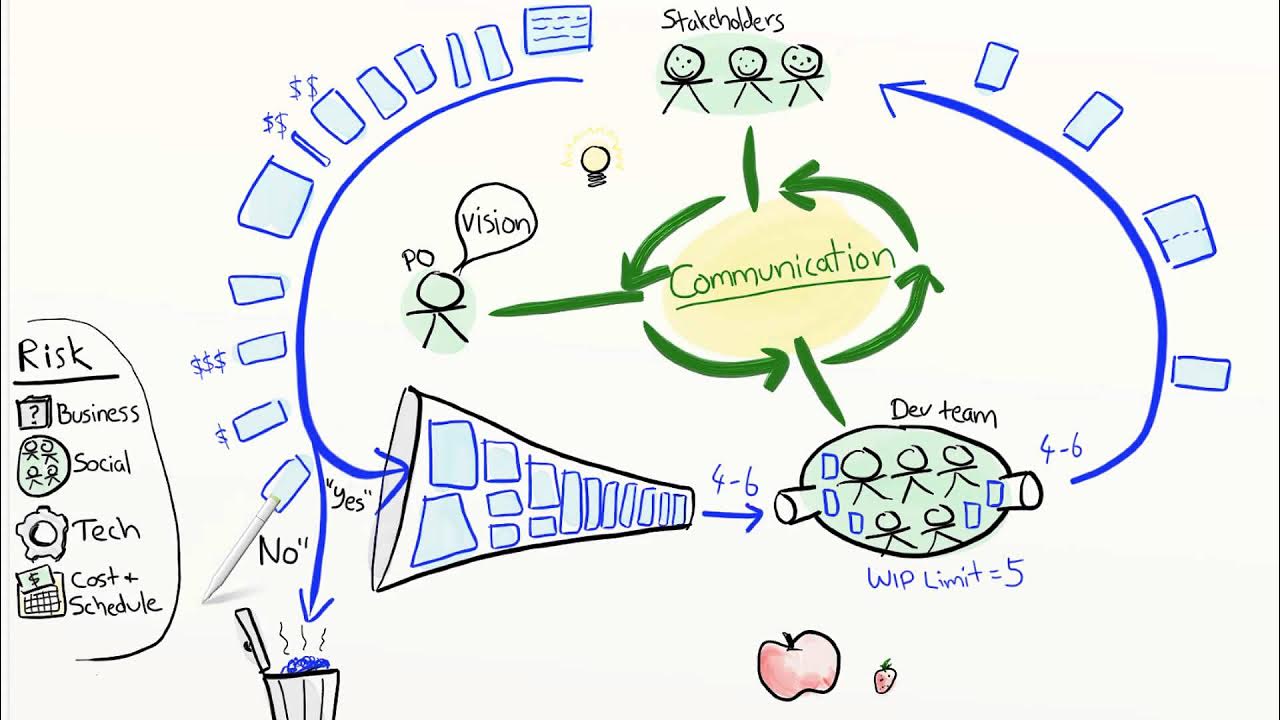Il ruolo di Product Owner Agile in 15 minuti
Summary
TLDRThe provided transcript discusses the agile software development process from the perspective of a Product Owner (PO). It emphasizes the PO's role in having a vision for the product, understanding the problem it will solve, and engaging with stakeholders. The importance of breaking down ideas into user stories and managing the product backlog is highlighted. The script touches on the Scrum framework, Kanban method, and the need for continuous integration with automated testing. It also addresses the challenge of balancing stakeholder expectations with the team's capacity, suggesting the use of a burn-up chart for realistic forecasting. The summary underscores the PO's critical tasks of prioritizing features, making decisions on which requests to accept or decline, and maintaining open communication with the development team and stakeholders. The essence of the agile approach is encapsulated in the need for adaptability, quick feedback loops, and the ability to continuously refine the product vision based on user input and market changes.
Takeaways
- 🔍 Agile software development focuses on the role of the 'Product Owner' who bridges stakeholders' needs with development, using user stories to translate requirements.
- 📈 The Product Owner's main tasks include managing the backlog, deciding what gets built, in what order, and continuously prioritizing and reprioritizing based on feedback and value.
- 🚀 Regular and early releases are a core principle in agile frameworks like Scrum and XP to adapt quickly and integrate stakeholder feedback effectively.
- 🛠️ Both Scrum and Kanban methodologies emphasize the importance of limiting work in progress to maintain quality and prevent team overload.
- 👥 Effective communication is crucial in agile processes; the Product Owner must ensure that the vision and priorities are clearly understood by both the team and stakeholders.
- 🔄 Agile development involves continuous estimation and re-estimation of the value and scope of user stories to adapt to new information and requirements.
- 📏 Agile teams strive to maintain a sustainable pace of development by managing workloads and not succumbing to the pressure of unrealistic stakeholder demands.
- 🎯 The Product Owner plays a critical role in managing expectations, being transparent about capabilities and timelines, and knowing when to say 'no' to preserve the integrity of the product roadmap.
- 🔗 In larger projects involving multiple teams, coordination becomes essential. This may involve a chief Product Owner who synchronizes the efforts and priorities across teams.
- 💡 The ultimate goal of agile is to deliver value efficiently, balancing risk, uncertainty, customer value, and team capabilities through continuous feedback and adjustments.
Q & A
What is the primary role of a product owner in Agile software development?
-The primary role of a product owner in Agile software development is to prioritize the product backlog, decide which features to accept or reject, and manage stakeholder expectations. They focus on delivering value, deciding not just what to build but also the sequence and importance of each feature.
How does an Agile development team manage its workload?
-An Agile development team manages its workload by using methods such as Scrum and Kanban to limit work in progress and ensure that they are working at a sustainable pace. They release features frequently, rather than making one large delivery at the end, and they focus heavily on automation to maintain quality without slowing down.
What is a user story in the context of Agile development?
-In Agile development, a user story is a tool used to capture a description of a software feature from an end-user perspective. It helps the team understand what the stakeholders need and why, by focusing on the problems the feature will solve and how it will be used.
Why is it important for an Agile team to have automated tests?
-Automated tests are crucial for Agile teams because they help maintain a high pace of development without compromising quality. Automated tests, including acceptance tests for each user story, allow frequent and reliable releases by ensuring that new features work as expected and do not break existing functionality.
What is the 'yesterday's weather' method in Agile?
-The 'yesterday's weather' method in Agile is a forecasting technique used to predict the team's future performance based on past performance. It assumes that the team's capacity in the upcoming period will likely be similar to what it was in the previous one, which helps in setting realistic goals and expectations.
What does limiting work in progress (WIP) entail in the Kanban method?
-In the Kanban method, limiting work in progress involves setting a maximum number of tasks or stories that the team can work on simultaneously. This helps to prevent overloading the team, ensures focus, improves flow, and maintains quality by reducing the amount of switching between tasks.
How does backlog refinement work in Agile?
-Backlog refinement in Agile involves regularly reviewing and updating the product backlog to ensure clarity and relevance of the user stories. The process includes estimating the size and value of stories, breaking larger stories into smaller, manageable pieces, and prioritizing them based on the latest information and stakeholder feedback.
What is the significance of a feedback loop in Agile?
-The feedback loop is significant in Agile as it allows the team to learn from the outcomes of their work and make continuous improvements. By frequently delivering work to real users and receiving feedback, the team can better understand user needs and adjust their efforts to maximize value and efficiency.
What challenges might a product owner face in managing the product backlog?
-A product owner faces challenges such as managing a growing number of stakeholder requests, prioritizing features that provide the most value, and saying 'no' to less critical requests to keep the backlog manageable and focused. They must also balance new features with maintenance and technical debt.
How do Agile teams handle stakeholder requests that exceed their delivery capacity?
-Agile teams handle excessive stakeholder requests by clearly communicating their capacity and using prioritization techniques to focus on the most valuable features first. They may also set expectations by using forecasting tools like burn-up charts to visually represent what can realistically be achieved within a given timeframe.
Outlines

هذا القسم متوفر فقط للمشتركين. يرجى الترقية للوصول إلى هذه الميزة.
قم بالترقية الآنMindmap

هذا القسم متوفر فقط للمشتركين. يرجى الترقية للوصول إلى هذه الميزة.
قم بالترقية الآنKeywords

هذا القسم متوفر فقط للمشتركين. يرجى الترقية للوصول إلى هذه الميزة.
قم بالترقية الآنHighlights

هذا القسم متوفر فقط للمشتركين. يرجى الترقية للوصول إلى هذه الميزة.
قم بالترقية الآنTranscripts

هذا القسم متوفر فقط للمشتركين. يرجى الترقية للوصول إلى هذه الميزة.
قم بالترقية الآنتصفح المزيد من مقاطع الفيديو ذات الصلة
5.0 / 5 (0 votes)






